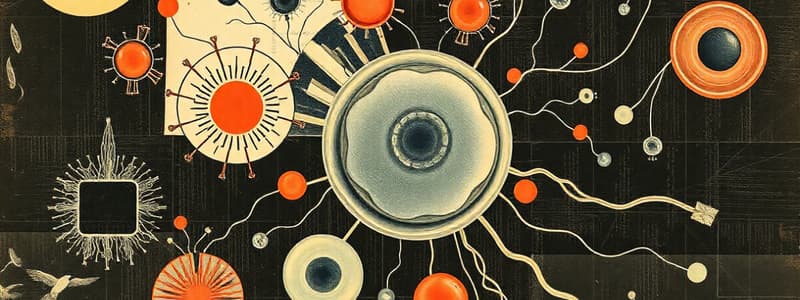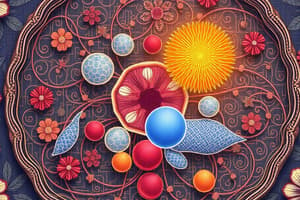Podcast
Questions and Answers
Contrast between plant and animal cell.
Contrast between plant and animal cell.
Plant cells have cell walls and chloroplasts, while animal cells do not.
List membrane-bound organelles.
List membrane-bound organelles.
Nucleus, Endoplasmic Reticulum (ER), Golgi apparatus, Lysosomes, Vacuoles, Mitochondria, Peroxisomes
Describe the main structures and the function of cell organelles.
Describe the main structures and the function of cell organelles.
Cell organelles have various structures that perform specific functions in the cell, such as protein production, energy creation, and waste disposal.
Describe the components of the endomembrane system and its function.
Describe the components of the endomembrane system and its function.
What is the function of the plasma membrane?
What is the function of the plasma membrane?
What is the main function of the cytoplasm?
What is the main function of the cytoplasm?
What is the main function of the nucleus?
What is the main function of the nucleus?
What is the main function of the ribosome?
What is the main function of the ribosome?
What is the main function of the endoplasmic reticulum (ER)?
What is the main function of the endoplasmic reticulum (ER)?
What is the main function of the Golgi body?
What is the main function of the Golgi body?
What is the main function of the vacuole?
What is the main function of the vacuole?
What is the main function of the endomembrane system?
What is the main function of the endomembrane system?
What is the main function of the mitochondria?
What is the main function of the mitochondria?
What is the main function of the peroxisomes?
What is the main function of the peroxisomes?
What three molecular structures make up the cytoskeleton?
What three molecular structures make up the cytoskeleton?
What is the function of the centrosomes and centrioles?
What is the function of the centrosomes and centrioles?
What is the function of the cilia and flagella?
What is the function of the cilia and flagella?
What is the function of the Chloroplasts?
What is the function of the Chloroplasts?
What is the function of the cell wall?
What is the function of the cell wall?
What is selective barrier within cells that allows sufficient passage of oxygen, nutrients, and waste?
What is selective barrier within cells that allows sufficient passage of oxygen, nutrients, and waste?
The general structure of a biological membrane is a single layer of phospholipids.
The general structure of a biological membrane is a single layer of phospholipids.
What are the two regions of the Endoplasmic Reticulum? (ER)
What are the two regions of the Endoplasmic Reticulum? (ER)
Match the layer of the cell wall with its description
Match the layer of the cell wall with its description
What is the extracellular matrix (ECM) made up of?
What is the extracellular matrix (ECM) made up of?
List the types of intercellular junctions
List the types of intercellular junctions
Flashcards
Plasma Membrane
Plasma Membrane
Selective barrier allowing passage of oxygen, nutrients, and waste.
Cytoplasm
Cytoplasm
Site for metabolic pathways within a cell.
Nucleus
Nucleus
Contains most of the cell's genes.
Ribosome
Ribosome
Signup and view all the flashcards
Endoplasmic Reticulum
Endoplasmic Reticulum
Signup and view all the flashcards
Golgi Body
Golgi Body
Signup and view all the flashcards
Lysosome
Lysosome
Signup and view all the flashcards
Vacuole
Vacuole
Signup and view all the flashcards
Endomembrane System
Endomembrane System
Signup and view all the flashcards
Mitochondria
Mitochondria
Signup and view all the flashcards
Peroxisomes
Peroxisomes
Signup and view all the flashcards
Cytoskeleton
Cytoskeleton
Signup and view all the flashcards
Centrosomes and Centrioles
Centrosomes and Centrioles
Signup and view all the flashcards
Cilia and Flagella
Cilia and Flagella
Signup and view all the flashcards
Chloroplasts
Chloroplasts
Signup and view all the flashcards
Cell Wall
Cell Wall
Signup and view all the flashcards
Fluid Mosaic Model
Fluid Mosaic Model
Signup and view all the flashcards
Phospholipid Bilayer
Phospholipid Bilayer
Signup and view all the flashcards
Cytoskeleton Roles
Cytoskeleton Roles
Signup and view all the flashcards
Cytoskeleton components
Cytoskeleton components
Signup and view all the flashcards
Microtubules
Microtubules
Signup and view all the flashcards
Microfilaments
Microfilaments
Signup and view all the flashcards
Intermediate Filaments
Intermediate Filaments
Signup and view all the flashcards
Centrosome Function
Centrosome Function
Signup and view all the flashcards
Cilia/Flagella structure
Cilia/Flagella structure
Signup and view all the flashcards
Plant Cell walls
Plant Cell walls
Signup and view all the flashcards
Primary Cell wall
Primary Cell wall
Signup and view all the flashcards
Extracellular Matrix
Extracellular Matrix
Signup and view all the flashcards
Intercellular Junctions
Intercellular Junctions
Signup and view all the flashcards
Plasmodesmata
Plasmodesmata
Signup and view all the flashcards
Tight junctions
Tight junctions
Signup and view all the flashcards
Desmosomes
Desmosomes
Signup and view all the flashcards
Gap junctions
Gap junctions
Signup and view all the flashcards
Nucleus
Nucleus
Signup and view all the flashcards
Study Notes
- Study notes for cell membrane-bound organelles are provided.
Learning Objectives
- Contrast between plant and animal cells
- List membrane-bound organelles
- Primary structures and the function of cell organelles
- Components of the endomembrane system
Common Organelles in Eukaryotes and Prokaryotes
- Plasma Membrane:
- It is a selective barrier.
- Allows sufficient passage of oxygen, nutrients, and waste.
- Phospholipid bilayer in eukaryotes.
- Cytoplasm:
- Serves as the location for metabolic pathways
- Composed of 90% water and 10% organic/inorganic compounds.
- Nucleus:
- Contains most of the cell's genes.
- Most conspicuous organelle.
- Chromatin (DNA + histones) condenses into chromosomes.
- The nucleolus is located inside and the site of ribosomal RNA (rRNA) synthesis.
- Ribosome:
- Protein factories carrying out protein synthesis in the cytosol
- composed of ribosomal RNA and protein as well as large and small units.
Eukaryote-Specific Organelles
- Endoplasmic Reticulum (ER):
- It is a biosynthetic factory.
- Smooth ER synthesizes lipids, metabolizes carbohydrates, detoxifies poison, and stores calcium.
- Rough ER secretes glycoproteins, distributes transport vesicles, and is a membrane factory
- Has rough ER w/ ribosomes and smooth ER without.
- Golgi Body:
- Modifies products of the ER
- Manufactures some macromolecules and packages materials for transport vesicles
- Consists of flattened membranous sacs called cisternae.
- Lysosome:
- Serves as digestive compartments.
- Lysosomal enzymes can hydrolyze proteins, fats, polysaccharides, and nucleic acids.
- Membranous sac of hydrolytic enzymes.
- Vacuole:
- Storage site for food, water, and waste;
- Large central vacuole helps maintain the shape of plant cells.
- Endomembrane System: Regulates protein traffic and performs metabolic functions in the cell.
- Includes the nuclear envelope, ER, Golgi apparatus, lysosomes, vacuoles, vesicles, and plasma membrane.
- Mitochondria:
- Powerhouse of the cell
- Site of cellular respiration
- Metabolic process that generates ATP
- Contains its own DNA.
- Peroxisomes:
- Involved in oxidation that produces hydrogen peroxide
- Converts peroxide to water.
- Specialized metabolic compartments bounded by a single membrane.
- Cytoskeleton:
- Provides support, motility, and regulation
- Organizes the cell's structures and activities and anchors organelles
- Network of fibers extending throughout the cytoplasm and composed of microtubules, microfilaments, and intermediate filaments.
- Centrosomes and Centrioles:
- The centrosome is a "microtubule-organizing center”
- Located near the nucleus.
- In animal cells, the centrosome has a pair of centrioles, each with nine triplets of microtubules arranged in a ring.
- Cilia and Flagella:
- Locomotor appendages of some cells.
- Core of microtubules sheathed by the plasma membrane; basal body anchors the cilium or the flagellum
- Dynein, a motor protein, drives the bending movement of cilia and flagella.
- Chloroplasts:
- Sites of photosynthesis.
- Found in plants and algae
- Contain chlorophyll.
- Thylakoids, membranous sacs, stacked to form a granum and stroma (internal fluid).
- Cell Wall:
- Protects the plant cell and maintains its shape
- Prevents excessive water uptake
- Extracellular structure made of cellulose fibers embedded in other polysaccharides and protein
- In plants, there are multiple layers that include the primary cell wall, middle lamella, and secondary cell wall.
Plasma Membrane
- Selective barrier facilitating passage of oxygen, and nutrients.
- Waste management for cell volume.
- General structure of a biological membrane is a double layer of phospholipids.
- Consists of two adjacent sheets of phospholipids arranged tail to tail.
- Hydrophobic tails associate internally.
- Polar heads contact inside and outside fluids.
Endomembrane System Regulation of Proteins
- Protein traffic regulator, metabolic functions.
- Component include the nuclear envelope, endoplasmic reticulum, Golgi apparatus, lysosomes, vacuoles, and the plasma membrane.
- Components are continuous and connected via transfer by vesicles.
- Nuclear envelope to the rough ER, continuous with smooth ER, is step 1 in the endomembrane system.
- ER-produced proteins transported via vesicles to the Golgi.
- Golgi pinches vesicles for lysosomes, specialized vesicles, and vacuoles.
- Lysosomes fuse with vesicles for digestion.
- Vesicles carries protein for membrane secretion
- Plasma membrane fuses with vesicles so proteins secrete.
Roles of the Cytoskeleton
- Supports cell shape via motor proteins.
- Vesicles travel on cytoskeleton monorails.
- Biochemical activities regulator.
Components of the Cytoskeleton
- Consists of three main fibers.
- Microtubules (thickest component).
- Microfilaments (thinnest actin filaments).
- Intermediate Filaments (fibers with diameters in a middle range).
Extracellular Components and Connections
- Cells secrete materials external to the plasma membrane.
- Includes cell walls, extracellular matrix (ECM), and intercellular junctions.
Types of Plant Cell Walls
- Distinguishes plant cells and provides shape and protection.
- Cellulose fibers in polysaccharides and proteins
- Multiple layers: primary cell wall, middle lamella, and secondary cell wall.
- Plasmodesmata serves as channels between plant cells.
Extracellular Matrix (ECM) of Animal Cells
- Animal cells are covered by an elaborate structure called extracellular matrix (ECM).
- The ECM is made up of glycoproteins: collagen, proteoglycans, and fibronectin
- ECM proteins bind to receptor proteins (integrins) in the plasma membrane.
Types of Intercellular Junctions
- Neighboring cells often directly interact via physical contact
- Junctions include plasmodesmata in plant and tight, desmosomes and gap junctions in animals.
- Plasmodesmata: channels perforate plant cell walls, facilitating the passage of water, small solutes, proteins, and RNA.
- Tight Junctions: prevents leakage of extracellular fluid
- Desmosomes: fasten cells together into strong sheets.
- Gap Junctions: communicating junctions between animal cells.
Studying That Suits You
Use AI to generate personalized quizzes and flashcards to suit your learning preferences.




